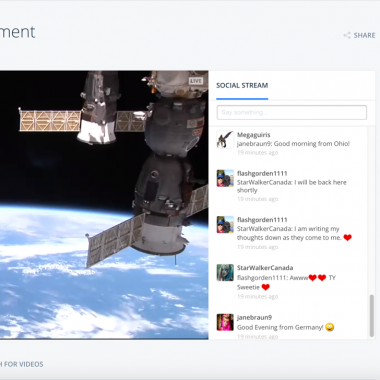Cloud Computing
Houston, We’re Live Streaming
November 17, 2016 | Written by: Bob Jacobs
Categorized: Cloud Computing
Share this post:
Since people around the world first gathered around black-and-white televisions to watch the 1969 moon landing, the general public has been fascinated by space, craving more visual information about the final frontier.
At NASA today, we are on a mission to find new ways to share our discoveries on Earth and in space.
Before the internet, the only way for the public to observe NASA activity was through television broadcast networks, satellite TV or cable providers. This access was typically limited to broadcasts of major events. To grow our presence and better engage with our audience, we needed a better way to broadcast a regular cadence of video feeds of the space program’s many scientific and technological feats.
How could we share the extraordinary experience of viewing the Earth from the International Space Station (ISS) and provide a way to interact with astronauts? Was it possible to bring the public into the NASA control room as the Curiosity Rover completed its journey to Mars? How could we give this access to virtually anyone, anywhere, on any device?
 When NASA began live streaming missions in 2004, live video over the internet was still in its infancy. Streaming video technology and capabilities expanded exponentially over the next decade, thanks in part to the cloud. At the same time, our own programs grew, as did the demands of our followers and our needs from streaming video providers.
When NASA began live streaming missions in 2004, live video over the internet was still in its infancy. Streaming video technology and capabilities expanded exponentially over the next decade, thanks in part to the cloud. At the same time, our own programs grew, as did the demands of our followers and our needs from streaming video providers.
We needed to ensure a reliable, high-quality viewing experience, as well as have confidence that we could handle a massively high volume of viewers, since millions of people watch NASA’s most popular events. For example, our broadcast of asteroid DA-14’s near-Earth fly-by in February 2013 drew a peak audience of 1.4 million concurrent live stream viewers.
We began streaming NASA missions over the cloud with Ustream, an IBM company, in 2009. Since then, NASA TV’s streaming capabilities and programming schedule have grown considerably. Today, Ustream video technology on the cloud enables NASA TV to air pre-recorded and live programming, 24 hours a day. The combination of cloud and video technology makes it possible for us to deliver high-quality, reliable video on an unprecedented scale.
We air live ISS coverage and related commentary each morning, and it repeats throughout the day. Ustream has also facilitated live viewing of NASA missions regularly throughout the year, including rocket launches, ISS resupply missions and events (spacewalks, media interviews, educational broadcasts), and press conferences. Our broadcasts often provide opportunities for space enthusiasts to ask questions of ISS astronauts via social channels, giving viewers a real-time, personal connection with NASA and our missions.
NASA’s premier missions, programs and projects help ensure that the United States remains the leader in space exploration, scientific discovery, aerospace, technology development and aeronautics. To maintain that leadership, NASA depends on public support and awareness.
Thanks to streaming technology, space enthusiasts the world over can still gather around a screen to watch an astronaut’s journey, but now that screen can be on a computer, a smartphone and a wide variety of other devices. NASA’s partnership with Ustream has enabled us to bring space out of the clouds and down to Earth. It is giving millions more people around the globe a front row seat as we strive to make the next giant leap for mankind.
For a deeper dive into live video streaming, read “5 Pro Tips for Live Video Production.”
______________________________________
This story first appeared on IBM’s Thoughts on Cloud.

Deputy Associate Administrator, Communications, NASA
Igniting the Dynamic Workforce in Your Company
In the rapid push to moving to remote work, we’ve seen digital strategies accelerate by years – transforming their workplaces, workstyles, and business processes forever. Overnight, remote workforces put advanced environments of multi-device mobility, dynamic connection points and robust cloud-based apps that ease communication and collaboration. A new normal is emerging, led by the companies aggressively adopting cloud […]
Q&A with Hillery Hunter, VP & CTO IBM Cloud on IBM’s Software Transformation
A couple of weeks after having closed its landmark acquisition of Red Hat, IBM is announcing new cloud capabilities that will transform the way clients do business and accelerate their journey to the cloud. This includes: IBM Cloud Paks, Red Hat OpenShift on IBM Cloud, Red Hat OpenShift on IBM Z and LinuxOne, and Consulting […]
Bringing AI and Blockchain to Bear on Environmental Challenges
IBM began focusing on environmental sustainability before the first Earth Day was ever celebrated. Addressing environmental challenges requires sustained action because even as we make progress, new challenges emerge. The digital transformation of our business and our clients’ businesses is improving the degree to which we can both examine and address global environmental challenges. Today, […]


